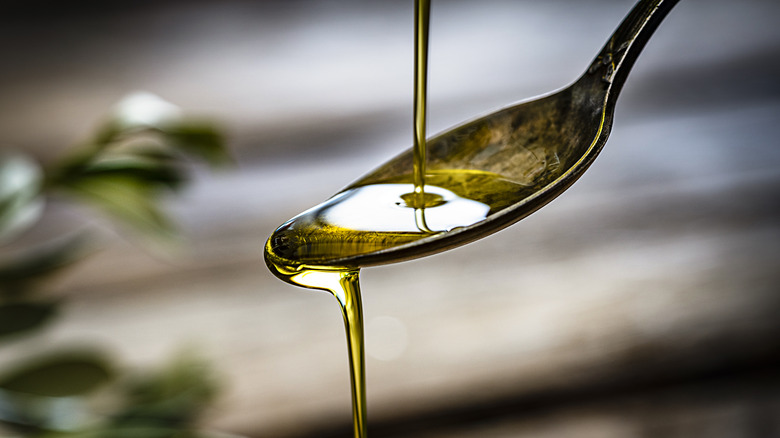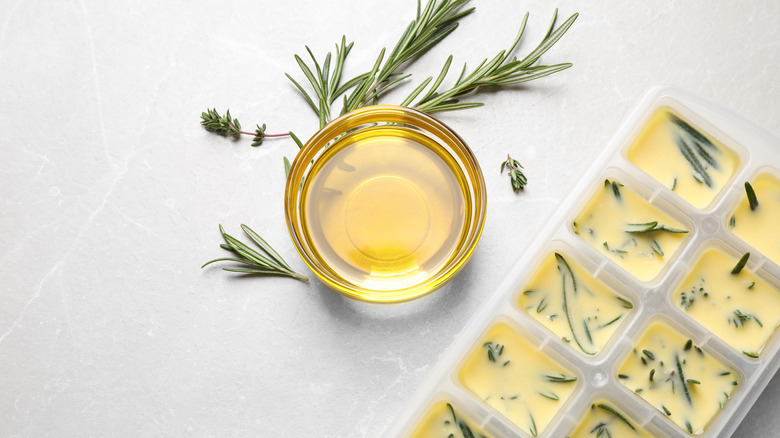What The White Flecks In Your Extra Virgin Olive Oil Are
Finding white spots or flecks in any food product is usually an indication that things have taken a turn for the worse. However, that may not be the case when it comes to extra virgin olive oil. Cold temperatures can cause components of olive oil to coagulate, so white flecks may simply be a result of cool storage conditions.
Olives are in a category of single-seeded fleshy fruits called drupes, which also includes plums, nectarines, and cherries. Just like these fruits, olives have a natural waxy skin. During olive oil production, olives are not peeled — they are sliced and crushed, and through the process, the skin gets broken down into tinier and tinier pieces. When the finished oil is stored at a low temperature, bits of the wax-like coating can sometimes separate out, resulting in white or cloudy flakes, clumps, crystals, sediment, or swirls. When kept below 50 degrees Fahrenheit, the oil may temporarily turn solid and hazy, but this does not affect the quality. In fact, some types of cooking oils fare better in the fridge, like cold-pressed extra virgin and infused olive oils.
Is olive oil with white flecks safe to eat?
Olive oil that has solidified particles in it is usually safe to eat. If you're not sure if the bits are from natural wax, or if they're an indication of spoilage, all you have to do is bring the oil to room temperature. If the flecks disappear and the oil turns clear and homogenous, you are good to go. If you want to use the oil in an uncooked application, like a salad dressing, you can speed up the defrosting process by placing the sealed oil bottle in a container of warm water, or pour some oil into a microwave-safe dish and heat for a few seconds on low power.
To minimize the chances of your oil separating at all, you could seek out winterized oils. Winterizing is a method for removing the wax solids in olive oil. The oil is cooled until it separates, then any sediment is scooped out. Winterizing does put the oil under additional processing and can dull the flavor of the final product, but it can be useful for those of us who live in a very cold climate and prefer not to defrost our olive oil all the time. Notably, unrefined extra virgin olive oil will not typically be winterized.
How can you tell if olive oil has gone bad?
If the flecks in your olive oil don't disappear when heated, tossing out the oil may be the best thing to do. However, many olive oils will last one to two years when stored properly. If you know your bottle isn't that old, you've been following all the right storage practices, and wasting oil is hard to swallow — especially since olive oil prices are at a record high — you can take further steps to tell if it's truly gone bad.
Visible mold can develop in infused olive oils, or in any oil where food or water was accidentally introduced to the bottle. If the white clumps look fuzzy, definitely get rid of the oil. Another way to tell if olive oil has gone bad is through taste or smell. On the nose and on the palate, the oil should be fresh, bright, and fruity, and it should not taste bitter, harsh, or tangy. Leandro Ravetti of Cobram Estates olive oil tells Real Simple, "If the oil tastes or smells like stale nuts, wax crayons, old lipstick, Play-Doh, or off meat, and leaves you with a fatty and waxy mouthfeel, the oil is likely rancid."



